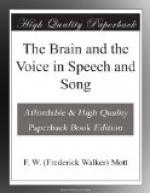An example of this was communicated by Darwin to Romanes. One of his children who was just beginning to speak, called a duck a “quack.” By an appreciation of the resemblance of qualities it next extended the term “quack” to denote all birds and insects on the one hand, and all fluid objects on the other. Lastly, by a still more delicate appreciation of resemblance the child called all coins “quack” because on the back of a French sou it had seen the representation of an eagle (Romanes’ “Mental Evolution in Man,” p. 183). Later on, children who have been educated acquire a knowledge of the application of visual symbols, and how to represent them by drawing and writing, and associate them with persons and objects.
3. There is more definiteness of impression and readiness of recall for auditory than for articulatory motor sense feelings.
4. After the acquirement of speech by the child, auditory feelings are still necessary for articulate speech processes; for if it were not so, how could we explain the fact that a child up to the fifth or sixth year in full possession of speech will become dumb if it loses the sense of hearing from middle-ear disease, unless it be educated later by lip language.
5. Cases have been recorded of bilateral lesion of the auditory centre of the brain producing loss of hearing and loss of speech, the motor centres being unaffected. This is called Wernicke’s sensory aphasia. The following case occurring in my own practice is probably the most complete instance recorded.
CASE OF DEAFNESS ARISING FROM DESTRUCTION OF THE AUDITORY CENTRES IN THE BRAIN CAUSING LOSS OF SPEECH
A woman at the age of twenty suddenly became unconscious and remained so for three hours; on recovery of consciousness it was found she could not speak; this condition remained for a fortnight; speech gradually returned, although it was impaired for a month or more. She married, but soon after marriage she suddenly lost her hearing completely, remaining permanently stone deaf; and although she could understand anything of a simple character when written, and was able imperfectly to copy sentences, she was unable to speak. Once, however, under great emotional excitement, while I was examining her by written questions, she uttered, “Is that.” But she was never heard to speak again during the subsequent five years that she lived. The utterance of those two words, however, showed that the loss of speech was not due to a defect of the physiological mechanism of the vocal instrument of speech, nor to the motor centres in the brain that preside over its movements in the production of articulate speech. She recognised pictures and expressed satisfaction or dissatisfaction when correct or incorrect names were written beneath the pictures; moreover, in many ways, by gestures, facial expression, and curious noises of a high-pitched, musical, whining character, showed that she was not




